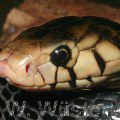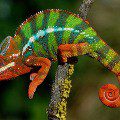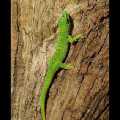
Madagascar day gecko
Among the representatives of the tropical fauna there are a lot of truly beautiful animals, often painted in amazingly bright colors. Perhaps this is due to the fact that the very nature of the tropics is distinguished by a riot of colors. For example, in tropical latitudes there are exotic birds painted in incredible shades, as well as exotic lizards, one of which will be discussed in this article. The Madagascar day gecko (Phelsuma madagascariensis) deserves to be known not only to herpetologists and avid terrariumists. Although among lovers of exotic reptiles, he is rightfully called a veteran of terrariums. What is so unusual about the daytime Madagascar gecko? First of all, it is a bright color of the body. Moreover, the colors that nature gave to this lizard are unlikely to find analogues among artificially created shades. The body of the Madagascar day gecko is rich velvety green in contrast with large bright red spots along its back. Moreover, different representatives of the species may have a variable color, for example, be green-blue with several small red patches or pure green with a red stripe on the back. The Madagascar gecko is named diurnal in accordance with the daily rhythms of its life. The lizard lives, as the name suggests, only in Madagascar and belongs to the genus Felsum, endemic to this island. By the way, one of the most common and largest subspecies of the Madagascar day gecko is called Phelsuma madagascariensis grandis for its amazing appearance.
Contents
Classification
Kingdom: Animals
Type: Chord
Superclass: Quadrupeds
Class: Reptiles
Order: Scaly
Suborder: Lizards
Infraorder: Geckos
Family: Geckos
Subfamily: True geckos
Genus: Felzumy
Species: Madagascar day gecko
Other names: Phelsuma madagascariensis, Madagascar gecko (English), Madagassischer Taggecko, Madagassischer Groβer Taggecko (German).
Appearance
 In size, daytime Madagascar geckos are usually not very large – 18-23 cm in length. But the magnificent felzuma grows up to 30 cm. In addition to bright red spots on the sides along the back, the reptile has wide red stripes on the sides of the head, passing into the corresponding edging of the eyes. The same large red spot is located in some subspecies of the Madagascar day gecko on top of the head, and on the back these spots tend to merge into short transverse stripes.
In size, daytime Madagascar geckos are usually not very large – 18-23 cm in length. But the magnificent felzuma grows up to 30 cm. In addition to bright red spots on the sides along the back, the reptile has wide red stripes on the sides of the head, passing into the corresponding edging of the eyes. The same large red spot is located in some subspecies of the Madagascar day gecko on top of the head, and on the back these spots tend to merge into short transverse stripes.
Sexual dimorphism in these reptiles takes place, but it is not particularly pronounced. Males are larger, the base of the tail is thicker, the head is wider than that of females, and yellowish prianal pores are also present. Some other species of Madagascar day geckos have their own characteristic features in color. For example, the decorated felzuma – a baby gecko, only 12 cm long, from the island of Mauritius, is considered the brightest among day geckos. Its body coloration combines a bright orange head with blue-green stripes, a brown neck, a bright blue torso with red spots, and a blue tail with red or orange stripes. And there are absolutely amazing colorful day geckos, for example, the four-eyed felsum and the Stranding felsum. The first is distinguished by a contrasting bright green dotted with red back, as well as blue and black spots and narrow white stripes on the body. The second day gecko, Strandinga, is perhaps one of the rarest species. The main tone of his body is grayish-turquoise, and there are dark gray blotches on his head and back.
In nature, daytime Madagascar geckos live no more than 10 years, and in a well-equipped terrarium live up to 20 years. These reptiles move very actively, despite the absence of claws on their paws and, due to their diurnal lifestyle, have a round pupil.
Distribution and habitation
So, the habitat of day geckos is limited to the island of Madagascar and nearby islands. Felzuma magnifica is found mainly in the northern part of the island and on the nearby island of Nosy Be. Other daytime Madagascar geckos have chosen the eastern territories of the island. These reptiles live in forest plantations, in the crowns of coconut palms and banana trees. But sometimes they can be found in human habitation scattered around the island.
Various subspecies of Madagascar day geckos occupy separate territories within the island. In particular, the typical gecko gravitates towards the east coast, the phelsum subspecies boehmei is found in the central east, and the subspecies kochi in the northwest. And only the magnificent felzuma is widespread throughout Madagascar.
The biotopes of daytime Madagascar geckos are very diverse. They can live in wet and dry forests, scrub vegetation and human settlements. But, like all other reptiles, it is common for geckos to hide in shelters, which can be hollows, stone blockages, spaces under tree roots, and even cracks in houses. Although the Madagascar geckos prefer daytime geckos, they are still trees, hiding among the foliage and becoming invisible due to the natural green hues prevailing in color. However, during the day, walking around the city, the Madagascar gecko can be seen on the wall of some building, and even on the city road.
Behavior and lifestyle
Madagascar day geckos are incredibly agile. Therefore, the terrarium for them is advised to choose a vertical one. Lizards easily move along its walls and ceiling. It is already clear that these geckos are exclusively diurnal. They are saved from enemies by a protective coloration that helps to merge with the surrounding nature, as well as easily torn skin, so that the reptile simply slips out of the enemy’s claws.
Madagascar day geckos are territorial creatures, and they prefer to live alone. It often happens that one felsum has its own personal tree, on which another lizard is unlikely to settle, and these trees are located at a sufficient distance from each other, at least 30 meters. A few individuals of Madagascar day geckos can occasionally be found only in pandanus – on an exotic plant known as bromeliad, which is a whole densely populated world of different creatures – insects, small amphibians and reptiles. Rainwater accumulates in the leaves of the bromeliad, so the humidity of this habitat is the most suitable for reptiles.
And finally, the rarest variant in nature is the felsum colonies. Madagascar day geckos gather in groups only while living in artificial structures, for example, under bridges, in the ruins of buildings, people’s houses, or even in garbage dumps. This is easily explained by the fact that in such places each lizard receives a sufficient amount of the resources necessary for life – water, warmth, food and shelter. However, fights are common in Madagascar day gecko colonies, although the weaker lizard prefers to run away.
Interestingly, male geckos tend to be solitary even in terms of viewing the surrounding area. They occupy a territory from which they do not see other males and are themselves invisible to them. The same territoriality is observed in the behavior of female Madagascar geckos, but not as pronounced as in males. During the day, these lizards perch on tree trunks exposed to the sun and soak up the heat. By the way, in the open sun, the body temperature of the felsum rises by several degrees.
Madagascar geckos also have their own hierarchy. In particular, older felsums occupy high areas of trees, while young ones sit lower. If the gecko notices danger, then it will almost immediately climb 2-3 meters higher in order to assess the degree of threat and understand whether it is worth returning to its original place. With the onset of night, daytime Madagascar geckos can either stay on trunks or hide in shelters, and during rainfall, lizards almost always hide. Felsums do not tend to descend to the ground at all, they do this only in exceptional cases, and then only in order to immediately climb a neighboring tree. Based on the behavior of Madagascar day geckos, herpetologists recommend equipping a spacious terrarium for them and keeping individuals one at a time.
Food
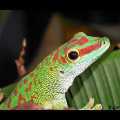 Madagascar diurnal geckos are, in general, omnivores. They do not refuse either plant food available on trees – fruits and flowers, or live food – small lizards, invertebrates, insects. And in the felsum environment, there are sometimes cases of cannibalism, when an adult eats young animals. In terrariums, the diet of Madagascar day geckos is subject to the general rules for reptiles. They should be given crickets, cockroaches, mealworms, locusts and other safe and non-poisonous insects, and you can also diversify the diet of newborn mice.
Madagascar diurnal geckos are, in general, omnivores. They do not refuse either plant food available on trees – fruits and flowers, or live food – small lizards, invertebrates, insects. And in the felsum environment, there are sometimes cases of cannibalism, when an adult eats young animals. In terrariums, the diet of Madagascar day geckos is subject to the general rules for reptiles. They should be given crickets, cockroaches, mealworms, locusts and other safe and non-poisonous insects, and you can also diversify the diet of newborn mice.
From plant foods, geckos are happy to feast on lettuce, dandelion and domestic plants – begonias, tradescantia. Among juicy fruits suitable for food, soft varieties are preferable – bananas, ripe pears, berries. Some owners even feed Madagascar day geckos honey and baby fruit mixes. But more emphasis should still be placed on animal food.
The recommended feeding frequency for lizards is at least once every two days. Zoologists do not advise overfeeding them, since in order to properly assimilate food, the gecko must have time to get hungry between feedings. And of course, do not forget about the diversity of the diet – a little of everything with various mineral supplements and top dressing for reptiles. Young Madagascar day geckos can be fed in the same way as adults, only in smaller portions.
Reproduction
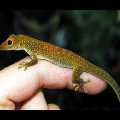 Daytime Madagascar geckos, like most reptiles, are egg-laying animals. Two years after birth, they acquire the ability to reproduce, and begin to breed after wintering. In terrariums, wintering for Madagascar day geckos is arranged artificially so as not to knock down their seasonal cycle. Then opposite-sex individuals are planted together for mating.
Daytime Madagascar geckos, like most reptiles, are egg-laying animals. Two years after birth, they acquire the ability to reproduce, and begin to breed after wintering. In terrariums, wintering for Madagascar day geckos is arranged artificially so as not to knock down their seasonal cycle. Then opposite-sex individuals are planted together for mating.
In nature, male daytime Madagascar geckos arrange quite cruel mating fights for the chosen one. The female prepares for laying within a month after fertilization. In nature, Madagascar day geckos make clutches right on the trees – in hollows, leaf axils and other possible shelters, only occasionally laying eggs in the ground. It is impossible to call female geckos especially prolific, the number of eggs is 1-2. But during the season, laying can be done up to 8 times with a period of a month. Terrarium gecko clutches are placed in an incubator where they develop until the young hatch. The higher the ambient temperature, the sooner Madagascar day geckos will hatch. The average incubation period is 2 months, with a delay due to temperature – 2 months.
The appearance of offspring is also interesting. Baby geckos open the shell with their egg tooth, but they don’t rush out right away, and they can stay in the egg for a whole day, exposing only their head. The offspring of daytime Madagascar geckos are born unusually bright, eventually acquiring a more restrained adult coloration.
Sources of
http://www.vitawater.ru/
http://www.zooclub.ru/
http://startcev.spb.ru
http://www.floranimal.ru
http://www.zoospravka.ru
http://terraria.ru
http://www.mad-love.ru/
Home



